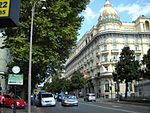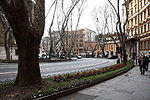San Nicola da Tolentino agli Orti Sallustiani

Not be confused with the church of San Nicolò da Tolentino in Venice, the Basilica di San Nicola in the town of Tolentino in the province of Macerata, or the Oratorio di San Nicola da Tolentino in Vicenza.San Nicola da Tolentino agli Orti Sallustiani (Italian: Saint Nicholas of Tolentino in the Gardens of Sallust) is a church in Rome. It is referred to in both Melchiori's and Venuti's guides as San Niccolò di Tolentino, and in the latter it adds the suffix a Capo le Case. It is one of the two Roman national churches of Armenia. The church was built for the Discalced Augustinians in 1599, and originally dedicated to the 13th century Augustinian monk, Saint Nicholas of Tolentino (also called San Niccolò or Nicolò da Tolentino).
Excerpt from the Wikipedia article San Nicola da Tolentino agli Orti Sallustiani (License: CC BY-SA 3.0, Authors, Images).San Nicola da Tolentino agli Orti Sallustiani
Salita di San Nicola da Tolentino, Rome Municipio Roma I
Geographical coordinates (GPS) Address Nearby Places Show on map
Geographical coordinates (GPS)
| Latitude | Longitude |
|---|---|
| N 41.905277777778 ° | E 12.491111111111 ° |
Address
Pontificio Collegio Armeno a Roma
Salita di San Nicola da Tolentino 17
00187 Rome, Municipio Roma I
Lazio, Italy
Open on Google Maps








